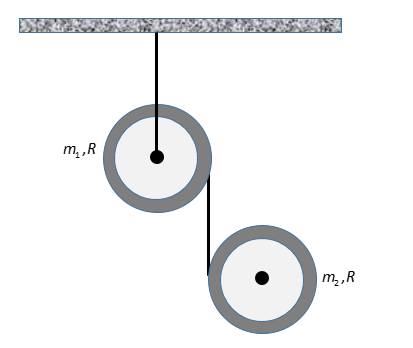
Linear acceleration of mass \[{m_2}\]is \[{a_2}\], then angular acceleration of \[{\alpha _1}\]is (given that there is no slipping).

A. \[\dfrac{{{a_2}}}{R}\]
B. \[\dfrac{{\left( {{a_2} + g} \right)}}{R}\]
C. \[\dfrac{{2\left( {{a_2} + g} \right)}}{R}\]
D. None of these
Answer
216.3k+ views
Hint: For no slipping condition or pure rotation condition the surface in contact is at instantaneous rest, i.e. the net force acting at that point is zero and hence there is no relative acceleration of the point.
Complete step by step solution:

Image: Two rings joined by common string
Let the tension in the string connected with mass \[{m_1}\] is \[{T_1}\] and the tension in the string connecting both the masses is \[{T_2}\]. \[{\alpha _1}\] is the acceleration of the mass \[{m_1}\], \[{a_2}\] is the linear acceleration of the mass \[{m_2}\] and \[{\alpha _2}\] is the angular acceleration of the mass \[{m_2}\].
For mass \[{m_2}\] writing the Newton’s 2nd law of motion,
\[\begin{array}{c}{F_{net}} = ma\\ \Rightarrow {m_2}g - {T_2} = {m_2}{a_2} \ldots \ldots \left( i \right)\end{array}\]
The moment of inertia of the circular ring about its centre of mass is given as,
\[I = M{R^2}\]
Here, \[M\] is the mass and \[R\] is the radius of the ring.
So,
\[\begin{array}{c}{I_1} = {m_1}{R^2}\\{I_2} = {m_2}{R^2}\end{array}\]
Net torque acting about the centre of mass \[{m_2}\] is \[{T_2}R\] and the direction is clockwise. For no slipping condition,
\[{a_2} = {\alpha _2}R\]
So, the angular acceleration will be,
\[{\alpha _2} = \dfrac{{{a_2}}}{R}\]
For mass\[{m_1}\],
Using no slipping condition,
\[{c}{\alpha _1} = {\alpha _2}\]
\[\therefore {\alpha _1}= \dfrac{{{a_2}}}{R}\]
Therefore, the correct option is A.
Note: We need to assume that the string connecting both the rings are massless and inextensible. If the string is not massless and inextensible then the tension at the point of contact will be different for both the rings. If the motion is not purely rolling/slipping then we can’t use the used relation between the angular acceleration and the linear acceleration for both the rings. The linear acceleration of mass \[{m_1}\] should be zero as its centre is attached to an inextensible and immovable string.
Complete step by step solution:

Image: Two rings joined by common string
Let the tension in the string connected with mass \[{m_1}\] is \[{T_1}\] and the tension in the string connecting both the masses is \[{T_2}\]. \[{\alpha _1}\] is the acceleration of the mass \[{m_1}\], \[{a_2}\] is the linear acceleration of the mass \[{m_2}\] and \[{\alpha _2}\] is the angular acceleration of the mass \[{m_2}\].
For mass \[{m_2}\] writing the Newton’s 2nd law of motion,
\[\begin{array}{c}{F_{net}} = ma\\ \Rightarrow {m_2}g - {T_2} = {m_2}{a_2} \ldots \ldots \left( i \right)\end{array}\]
The moment of inertia of the circular ring about its centre of mass is given as,
\[I = M{R^2}\]
Here, \[M\] is the mass and \[R\] is the radius of the ring.
So,
\[\begin{array}{c}{I_1} = {m_1}{R^2}\\{I_2} = {m_2}{R^2}\end{array}\]
Net torque acting about the centre of mass \[{m_2}\] is \[{T_2}R\] and the direction is clockwise. For no slipping condition,
\[{a_2} = {\alpha _2}R\]
So, the angular acceleration will be,
\[{\alpha _2} = \dfrac{{{a_2}}}{R}\]
For mass\[{m_1}\],
Using no slipping condition,
\[{c}{\alpha _1} = {\alpha _2}\]
\[\therefore {\alpha _1}= \dfrac{{{a_2}}}{R}\]
Therefore, the correct option is A.
Note: We need to assume that the string connecting both the rings are massless and inextensible. If the string is not massless and inextensible then the tension at the point of contact will be different for both the rings. If the motion is not purely rolling/slipping then we can’t use the used relation between the angular acceleration and the linear acceleration for both the rings. The linear acceleration of mass \[{m_1}\] should be zero as its centre is attached to an inextensible and immovable string.
Recently Updated Pages
JEE Atomic Structure and Chemical Bonding important Concepts and Tips

JEE Amino Acids and Peptides Important Concepts and Tips for Exam Preparation

Electricity and Magnetism Explained: Key Concepts & Applications

Chemical Properties of Hydrogen - Important Concepts for JEE Exam Preparation

JEE Energetics Important Concepts and Tips for Exam Preparation

JEE Isolation, Preparation and Properties of Non-metals Important Concepts and Tips for Exam Preparation

Trending doubts
Understanding Electromagnetic Waves and Their Importance

Geostationary and Geosynchronous Satellites Explained

Inertial and Non-Inertial Frame of Reference Explained

Clemmensen and Wolff Kishner Reductions Explained for JEE & NEET

JEE Main 2023 January 29th Shift 2 Physics Question Paper with Answer Keys and Solutions

Current Loop as a Magnetic Dipole: Concept, Derivation, and Examples

Other Pages
NCERT Solutions for Class 11 Physics Chapter 3 Motion In A Plane 2025-26

Motion In A Plane Class 11 Physics Chapter 3 CBSE Notes - 2025-26

Two identical balls are projected one vertically up class 11 physics JEE_MAIN

NCERT Solutions For Class 11 Physics Chapter 13 Oscillations - 2025-26

Work Energy and Power Class 11 Physics Chapter 5 CBSE Notes - 2025-26

JEE Main Correction Window 2026 Session 1 Dates Announced - Edit Form Details, Dates and Link




